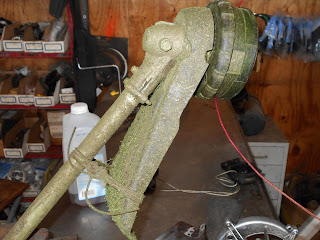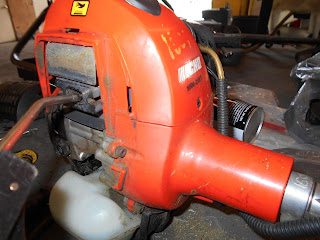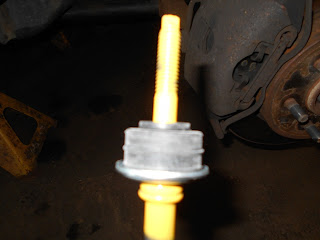After nineteen months working for a small landscape company in Bucks County, Pennsylvania, I came to the realization that I cannot work with stupid anymore. It's painful, to say the least. The term "stupid" in this case refers to working with a group of people that are supposed to be professionals with years and years of experience that never really showed in their conduct. Using broken equipment and breaking it some more in the process, taking trucks on the road that they should not have, and when they get caught, call me to wave my magic wand to fix it (because I have all sorts of influence over local law enforcement you know). Working with a bunch of kids, that with few exceptions, just didn't get it. And my personal favorite, working with managers that were clueless with two or three exceptions.
I had begun the process of seriously looking for a new job earlier in the year, and while I did get a few offers, nothing really sparked my interest. There was a place that wanted me to work all outside on their fleet, on a part time basis. Another interesting place would have me working on anything from your average econobox to antique Volkswagens and BMWs, like an Isetta. (Remember the TV show family matters? Remember Urkel's car? That thing.)
After a long search, keeping in mind that I did not have to take the first job that made an offer to me, I finally found a place that seems to have its shit together.
I started the new job on January 4, doing the same thing (fleet maintenance) I have been doing for a few years on a full time basis now. If you have changed jobs, then you probably know about the feelings on starting that new job. Things like being worried if you made the right choice or if this move was a mistake. If this doesn't work out, then what?
I made the right choice.
The new job hired me as a mechanic/shop supervisor. When they did this, they gave me an offer letter, on their company letterhead, that spells out exactly what I am to do and exactly what my responsibilities are. This offer letter is three pages long. I was also given a copy of the handbook (rulebook for my foreign friends) to keep and refer to, should I have questions regarding policies and such. This offer letter includes items such as paid time off, health insurance and holiday pay (included in the paid time off statement.) There is room to grow in this position.
The old job, upon hearing of my intention to leave (because giving notice is the right thing to do, never burn a bridge if you can possibly avoid it) did present a counter offer. It was one page, on legal pad paper. There were four lines total. All about money, which for the record I mentioned one time. It basically read that if I were to take up residence there for 60 hours per week I could make more money. Again I mentioned money one time. This offer letter promised me one week vacation per year, which would be paid at 40 hours. A far cry short of what I would need to put in to make the promised amount per year. There is no room to grow in this position.
The old job, especially its owner/president/ski bum wouldn't even say f**k you the last week I was there, with very few exceptions. They were kind enough to leave me a list of things to do that I could not get accomplished since trucks need to sit still for that to happen.
The new job sent me an email hoping me and my family had a happy holiday. Note that this was before I started.
We had a blizzard last weekend on the east coast. Two feet of snow fell and while I was at work from Friday night to Sunday night, I was paid extra for this. Extra on top of my salary. It was too dangerous to go home (remember, two feet of snow) and I had to be back Sunday morning for more snow removal. The new job is reimbursing me for a hotel stay at a place within walking distance of the shop. I even got a $50.00 tip, if you will, directly from the owner's pocket.
No way in hell would the old job do that. While yes the old job did pay extra during snow removal (a whole two dollars per hour extra) it was only while bailing out someone stupid enough to not check their machine. I was based out of my home for these things, I was assigned a truck (an uninspected truck with multiple issues, mind you) and I could get around, but the phone calls would wake her up. With the new job, since I was there, no phone calls to wake her up. This is a good thing.
The old job has some equipment that is bordering on forty years old. The average age of a fleet vehicle, using what they define as a fleet vehicle, is 16 years old. Most of this fleet has major rust issues. In fact, I bought a pair of off road goggles just to keep the falling rust out of my eyes. They have a few tractors that frankly need lots of work to keep them going.
The new job has an average fleet vehicle age of eight years, using what they define as a fleet vehicle. The undercarriage rust is minimal, and there is someone on staff that repairs rust holes in the truck bodies. (I am nobody's paint and body man. I never have been.) I still wear my goggles but it's not like if you were to smack the truck that ten pounds of rust would fall on you.
Last but not least, yesterday the general manager sent me a text thanking me for my service this past week and wishing me rest for the upcoming week. The day before he was kind enough to look into an issue for me and get me an answer that day. The office administrator had a question about the child support paperwork earlier in the month, and instead of "winging it" called me about it, because after years of being in their system, I just might have the answer they need. The company owner has sent help to my shop to clean up trucks from the storm and help with snow blower diagnosis. Qualified help in this case.
The old job, on the other hand, would send me the owner's brother in law. They could keep him doing something else as far as I am concerned, because, as my grandfather would say, the man is about as useless as the **** on a boar hog. Questions on child support were winged at best, and I would personally like to take this opportunity to thank the old job for costing me money in the form of having to take off work to go work out the payment problem that the old job created by not sending in enough money for the first month or so I worked there.
Let us not think for a moment that I died and went to mechanic heaven, because no job is perfect. I have an assistant that can be quite the insolent little jerk. Last Friday was not a good day for me because nothing wanted to go together right and one of my bobcat loaders decided to break down on a jobsite. Earlier in the week I got to deal with Bobcat regarding some goof ass entering a password on the machine to prevent it from starting, and forgetting to tell anyone about it. Plows break down, drivers break things and destroy transfer cases, and in general it got rough at times because you never knew what to expect next. I can say that management above me and my assistant did make things easier by jumping in when needed, whether it be the assistant getting a plow going again, or the general manager getting me a phone number to call technical support.
I think it is safe to say I have had one bad day since starting the new job. As mentioned earlier this is because nothing was going right, and this is to be expected. The old job, on the other hand, caused a panic within the first two hours of my first day on the job, which should have been a huge red flag. A panic that it turned out did not have to happen, had the driver used some common sense.
Oh one last thing. I actually received a uniform allotment before I started the new job. Shirts, sweatshirts, and a now ruined hoodie, so that I did not have to ruin more of my own clothes when working on their equipment. The cycle was that I would wear older t shirts to work so that when I got grease and crap on them nobody would care, new shirts were worn and relegated to work shirt and so forth. I received a shirt only when I managed to get a diesel fuel bath while changing a fuel filter on a big ford truck.
I made the right choice.









































